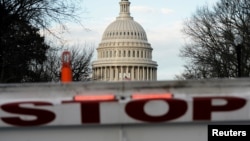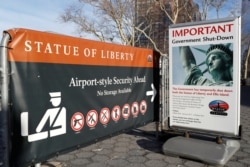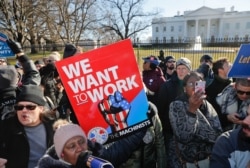If Congress fails to act, the U.S. government's authority to continue spending money will expire at midnight on Thursday, forcing more than 1 million federal workers and an untold number of contractors to stop working. Thousands more will be expected to continue working without clarity about precisely when they will be paid.
"The stakes are whether the United States government is able to answer the many challenges that we face as a country," said Max Stier, president of the Partnership for Public Service, an advocacy group for improved federal government.
And once the government shuts down, Stier said, restarting it isn't like flipping a switch.
"This is a multitrillion-dollar, very complex entity," he told VOA. "And so, turning it off and turning it back on actually takes a ton of energy and a bunch of time. So, it is highly costly — billions of dollars costly — when you have a shutdown, even if it's not for a very long period of time."
History of shutdowns
Since 1980, the federal government has shut down because of a lack of funding 21 different times.
This would be the first government shutdown of President Joe Biden's term in office. Going back to Jimmy Carter's term in office from 1977 to 1981, every U.S. president except for George W. Bush has experienced at least one such funding crisis, though the majority have lasted only a few days and several have been for a few hours.
The last time the government shut down was in 2018, when a dispute between then-President Donald Trump and congressional Democrats over his proposal to build a wall on the U.S. border with Mexico resulted in a record-setting 35-day partial closure that stretched into January 2019.
Not a full shutdown
The term "government shutdown" is something of a misnomer. Under existing rules, when the government runs out of funding, federal agencies are required to furlough all "nonessential" employees. Doctors and nurses at hospitals run by the Department of Veterans Affairs will still be allowed to go to work. So will Transportation Security Agency officers, active duty members of the military and most federal law enforcement officers.
But employees deemed essential will still not be paid until the shutdown is resolved.
In a sign of the degree to which government shutdowns have been normalized as just part of how Washington does business, Trump in 2019 signed the Government Employee Fair Treatment Act, which guarantees that federal workers, essential and nonessential, receive the back pay they missed during the duration of any future government shutdowns.
However, Everett Kelley, president of the American Federation of Government Employees, said that a promise of getting paid eventually is cold comfort to a federal worker unable to pay their rent.
"So many of our members live paycheck to paycheck," Kelley told VOA. "Unless a creditor or landlord agrees to work with them, they're going to be in a terrible situation."
If financial distress winds up affecting a furloughed employee's credit rating, Kelley said, the damage can extend to their careers. "A lot of security clearances depend on your credit rating," Kelley said, meaning that workers whose credit suffers could lose their jobs.
What to expect
In past shutdowns, the most publicly visible effects were the closure of national parks and the museums near the National Mall in Washington, D.C. Those would also likely happen this time around. But it's beneath the surface where shutdowns cause real turmoil.
About 60% of government employees would be barred from working during a shutdown, which means that any number of seemingly mundane procedures would stop happening. New passport applications wouldn't be processed; small business loans wouldn't be approved; requests for federal retirement benefits would stop moving through the system.
Most Americans would not be immediately affected by stalled government activity. But those who are — a person waiting for a passport, a small-business owner waiting for funding, a retiree needing income — could face anything from inconvenience to significant economic injury.
Employees of government contractors are particularly vulnerable. For example, Congress has contracts with private firms to supply the workers who provide food service on Capitol Hill and clean congressional offices. During a shutdown, those workers cannot work, and because they are paid an hourly wage rather than a salary, they rarely recover those lost wages.
Economic damage is limited and localized
The 35-day shutdown during the Trump administration was only partial, because before it began, Congress had passed funding measures for some agencies, most notably the Department of Defense.
Nevertheless, the Congressional Budget Office later estimated that the shutdown had "delayed approximately $18 billion in federal discretionary spending for compensation and purchases of goods and services, and suspended some federal services."
The overall impact on GDP was minor, the CBO found. During the shutdown and immediately following it, economic activity slumped noticeably, but much of that "lost" productivity was recouped later in the year. On balance, the CBO said that the 35-day shutdown cut 2019 GDP in the U.S. by just 0.02%
However, the CBO noted, the damage from the shutdown was not equally distributed.
"Underlying those effects on the overall economy are much more significant effects on individual businesses and workers," the agency found. "Among those who experienced the largest and most direct negative effects are federal workers who faced delayed compensation and private-sector entities that lost business. Some of those private-sector entities will never recoup that lost income."
'Completely irresponsible'
Kelley, of the American Federation of Government Employees, pointed out that it is unprecedented for the government to be shut down in the midst of a pandemic, calling it "completely irresponsible" to hobble agencies battling COVID-19 with staff shortages.
"Shutting down the government at this critical juncture, in this fight against the dangerous delta variant (of the COVID-19 virus) is simply unthinkable," he said.
Stier, whose organization prepared detailed guidance for government agencies navigating shutdowns, said all that guidance had to be rewritten to reflect employees working remotely, and that new measures remain untested.





























